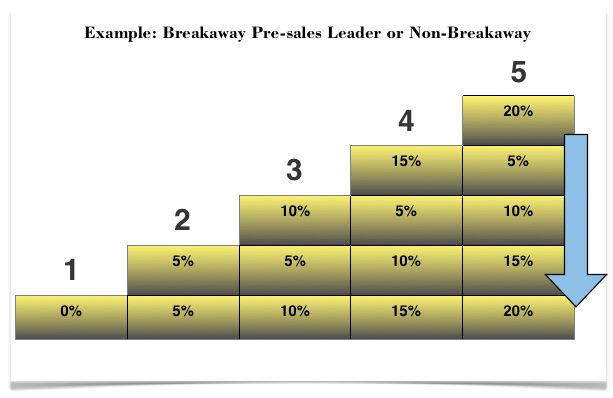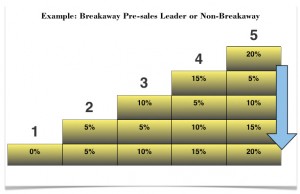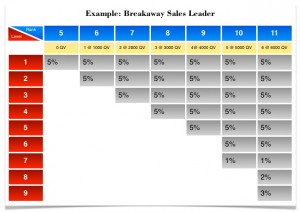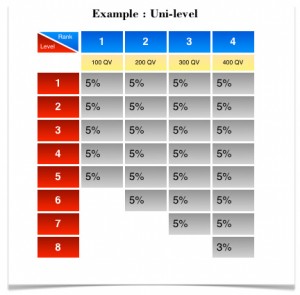SHARE
Bringing Compensation Plans Into Perspective Part 3

The Three Proven Compensation Plans
Over the last 25 years, three predominant compensation plan types have been implemented by select network marketing companies to achieve landslide success:
• Breakaway • Hybrid Uni-level • Binary
Each of these plans can work and be a good choice. Herbalife, NuSkin, XanGo, Tahitian Noni, Melaleuca, Isagenix and Synergy are all living color examples!
I cannot emphasize enough that the type compensation plan your company chooses is of the utmost significance! When you create your own MLM business, one of your most essential priorities and responsibilities is to design a compensation plan that fits your company’s unique needs and offers a mix of elements that will take your company to the top. For example, the business model your company chooses, i.e., Party Plan, must be considered in choosing the type of compensation plan you use because it has a profound effect on every aspect of business operation. Whichever compensation plan you choose—Breakaway, Hybrid Uni-level, or Binary— each has its own specific, unique set of challenges.
Breakaway
A Breakaway Compensation Plan includes very defined sales force classifications: 1) distributor and 2) sales leader. Commissions are paid very differently on each of them. A new distributor is basically considered a pre-sales leader. When that individual advances to a designated level, he/ she breaks away from his/her sponsor and forms his/her own group as a sales leader. The plan then pays this distributor—called a breakaway—a new, different type of commission. It is usually referred to as a sales leader override. His/her group volume is no longer included in his/her sponsor’s group volume. Instead, the sponsor receives breakaway volume—a smaller percentage. And, the sponsor must go out and replace this person in his/ her organization.
For example, last month, you had ten people in your personal group helping you qualify. This month two of them broke away, so now you don’t receive group commission on those two, and you have to replace them. If you are a breakaway/sales leader, you’re always going to make more money on your group volume—on the distributors in your downline—than you are on your breakaways/sales leaders. On your group volume, you may earn as much as 15-25%, and on your breakaway volume, you may earn as little as 3-6%. Distributors make more money on their group than on their sales leaders because of the commission differential.
The Breakaway Compensation Plan typically uses at least two commission types:
1. Non-Breakaway Commission: Commission paid on group volume to: 1) non breakaways, or 2) sales leaders on their non-breakaway group [See Figure 4]. This is typically a level or stairstep commission. A level commission pays distributors a percentage on a certain number of levels of their downline. A stairstep commission is a differential commission comprised of progressive steps with specific requirements, and as distributors meet the requirements to climb the steps, they earn increasing percentages on their personal and group volume.
2. Breakaway Commission: A breakaway/sales leader commission paid on the group volume of downline breakaways/sales leaders [See Figure 5.] This is typically a level commission.
Many of these plans also have some small pool or infinity commissions, however, they typically make up a very small percentage of the overall payout. A pool commission is an amount of money set aside and then divided up among those distributors who meet particular qualifications. It is used to reward very specific activities. A certain percentage of sales—for example, 1%—is set aside in a pool; this money is distributed to all who achieve a certain goal set by the company. An infinity commission is a commission paid on all volume in a distributor’s organization down to the next individual with the same rank.
Figure 4: Breakaway – Pre-sales Leader or Non-Breakaway Commission.
Figure 5: Example Breakaway Sales Leader Commission.
Breakaway and the 5% Theory
Here’s an example of the 5% theory in a Breakaway Compensation Plan: If Mark sponsors Jerry, a new distributor, and Jerry buys a $100 worth of product, Mark earns 20% or $20. It’s worth it to Mark to deliver the product and personally answer Jerry’s questions as a retail customer. On the other hand, let’s say Mark sponsors Linda, and she takes the initiative to go out and sell a lot of product—as much as $2,000—and becomes a breakaway/ sales leader on her own. She doesn’t require a lot of management or hand holding, so she makes the 20% on all the product she sells. Mark makes 5% sales leader commission. So, instead of making 20% or $400 on her $2,000, he makes 5% or $100. And, his management responsibilities are not nearly as great as with Jerry.
Strengths of Breakaways
• Breakaway Compensation Plans are very predictable.
• One of the real advantages of this plan is that because you have two commission types specifically set aside—one for paying salespeople and one for paying sales management—it’s much easier to set the percentages and qualifications to achieve the desired results. Consequently, professional distributors can be better taken care of with this plan.
• The plan does a great job of paying salespeople. Of all of the standard compensation plans, this one has the strongest potential in this area. Once you become a sales leader, it allows you to make a lot more money on your customers and brand new distributors—those who need your help. Consequently, you have a lot more incentive to work with them. On the people who have advanced to breakaway/sales leader, you’re now earning 5%. However, since you get paid down numerous levels of sales leaders—successful people—this means you get paid on a lot of group volume.
• The plan uses level commissions on group volume for paying sales leaders—the most successful method for paying sales management commissions.
• The fact that this plan has defined a certain commission type to pay salespeople and another commission type to pay sales management simplifies the design and creation of qualifications.
• This plan encourages the registration of every consumer with the company, which has been made possible with the Internet, and this is something many companies desire.
• The Breakaway is an easy plan on which to pay a worldwide, integrated, seamless commission.
• The two commission types used in this plan are easy to understand.
Weaknesses of Breakaways
• This plan is sometimes viewed as a compromise plan.
• Since many people don’t build an organization—probably 90%—they stay in other distributors’ personal groups.
• When you get two people on the same step, the differential is zero.
• With this plan, there is a treadmill effect. When you bring someone in, you have to qualify those group volumes, and as people break away, you have to replace that volume.
Summary
Overall, in specific circumstances, this plan has a lot to offer a company. It’s reasonably simple but can be designed to create focus on getting commissions to either salespeople or sales leaders based on the needs of the company.
Hybrid Uni-level
Most of the plans that are called Uni-levels today are actually Hybrid Uni- levels. In other words, the Uni-level Plan is typically the backbone and then other commissions like fast starts and/or pool bonuses are added to increase earnings. So, this plan features a level commission as the primary commission. Some of the common additions to the level commission include:
• Fast start commission.
• “Mini-barrier” plan that has everyone sign up as a preferred consumer and then automatically advance to distributor when he/she qualifies.
• A small differential or single level commission on the front of the plan. Typically, this is done by overlapping infinity commissions at the intermediate ranks. A differential commission maximizes commissions for those who are doing what the compensation plan is designed to reward. It targets a specific activity.
• Level commission percentages that change as a distributor’s rank changes.
• Pool commissions for the top ranks.
• Infinity commissions for the top ranks.
• Conversion from a level commission paid on personal volume to a level commission paid on group volume.
• Dynamic compression.
Table 1: Example Fast Start
In a Uni-level Compensation Plan, everyone is a distributor. You get paid on your distributors down X number of levels, and the company tries to get extra money to you by creating a different kind of differentiation besides sales force classifications. In other words, this plan is built on the standard 5% commission to everyone plus add-on commissions that target groups.
Caution: With this plan, make sure to note how the different types of commissions in your mix interact. You might find some conflicts or opposing forces at play. Eliminate them quickly!
Figure 6: Example Uni-level with 4 Ranks.
Note: Although Figure 4, illustrating the Breakaway Plan, and Figure 6, illustrating the Uni-level Plan, may look similar, they really are entirely different. Remember, in a Breakaway Plan, everyone who is a pre-sales leader gets paid according to one payout scale, but as soon as he/she breaks away to sales leader, he/she gets paid on a scale. In a Uni-level, everyone gets paid at the same level forever.
Many of the Hybrid Uni-level Compensation Plans use a fast start commission, which is a different commission schedule paid on new distributors for the first one to three months after being sponsored. The division of this plan is time. So, when I sign you up, I make more on you when you come on board and less later. The challenge is to create a segment of the downline distributors can make a higher percentage on. Without a good fast start program, a Uni-level Plan will stay close to the 5% earnings line. [See Figure 1, Standard 5% Earnings and 5% Plus Curve.] A fast start can bump earnings up to 7-12%.
you may also like
Essential Software Customizations for MLM, Direct Selling, and Affiliate E-commerce
Navigating the changing landscape of e-commerce, particularly within MLM, direct selling, and affiliate marketing channels, requires more…
How to Ensure Your Compensation Plan and Software Work Well Together
Peanut butter and jelly. Milk and cookies. Batman and Robin. Everybody knows these famous pairings work well…
Podcast 53: Advantages Using an Interim VP of Sales for Direct Selling Companies
Today we welcome a returning guest of this podcast: Jeff Jordan. Jeff has also written articles for…
compensation consulting for mlm companies
We offer data-driven compensation plan design & analysis
MLM.com Newsletter
Get our e-mail newsletter, with MLM.com articles & online exclusives, delivered to your inbox each week.













